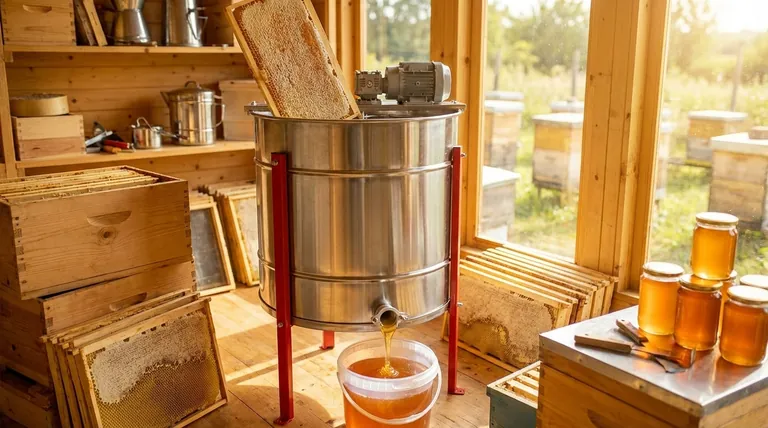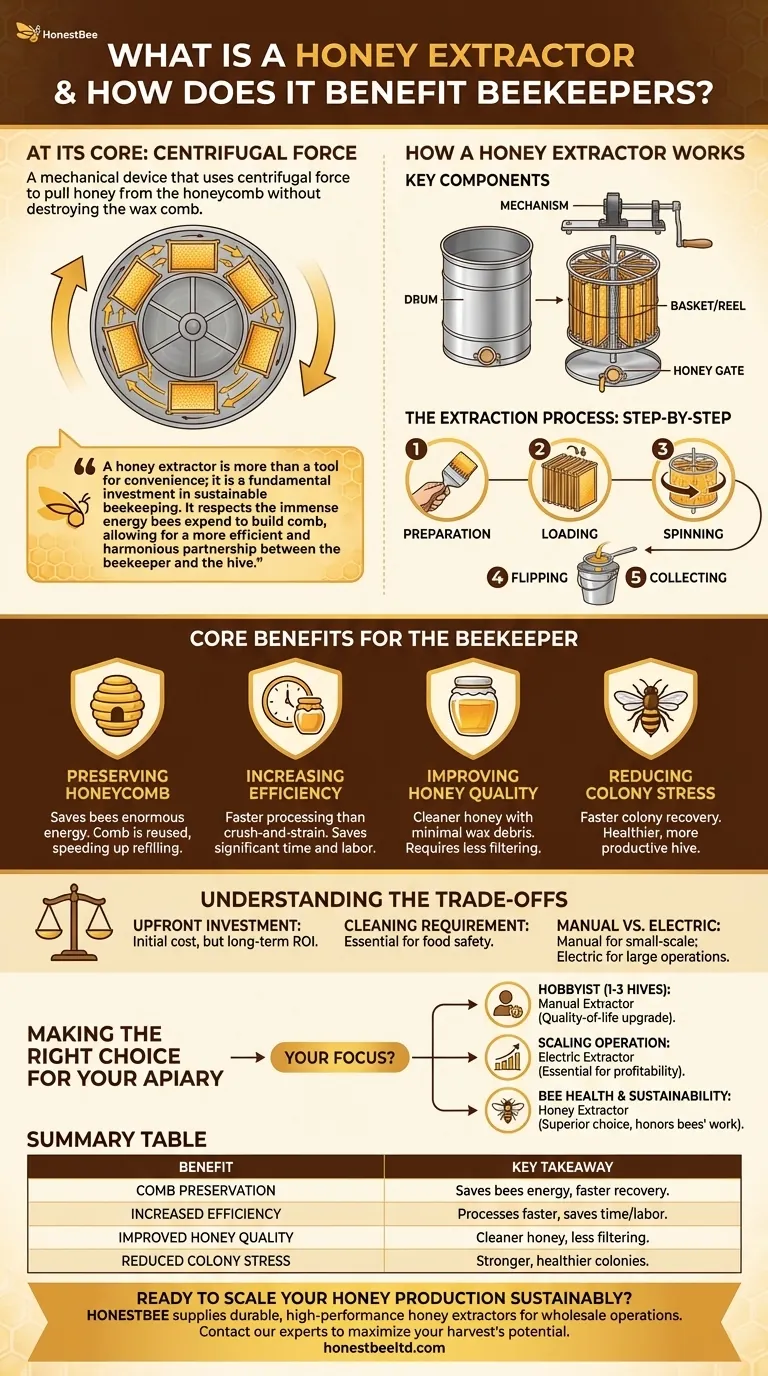At its core, a honey extractor is a mechanical device that uses centrifugal force to pull honey from the honeycomb. Beekeepers place uncapped frames of honey into a basket inside a drum, spin it, and the force slings the honey out where it can be collected. This method's primary benefit is that it removes the honey without destroying the delicate wax comb, which can then be returned to the hive for the bees to reuse.
A honey extractor is more than a tool for convenience; it is a fundamental investment in sustainable beekeeping. It respects the immense energy bees expend to build comb, allowing for a more efficient and harmonious partnership between the beekeeper and the hive.

How a Honey Extractor Works
A honey extractor operates on a simple, effective principle. Understanding its mechanics reveals why it is so central to modern beekeeping.
The Principle of Centrifugal Force
The device is a type of centrifuge. As the internal basket holding the honey frames spins at high speed, the liquid honey is forced outward, away from the center of rotation. It hits the inner wall of the drum and drips down to the bottom for collection.
Key Components
Every extractor has a few basic parts: a large, typically stainless steel drum to contain the honey, a basket or reel to hold the frames vertically, and a mechanism to spin the basket. This can be a manual hand-crank or an electric motor for larger operations. A honey gate or spigot at the bottom allows for clean, controlled draining.
The Extraction Process Step-by-Step
- Preparation: Before frames enter the extractor, the beekeeper uses a special tool to gently remove the thin wax cappings that bees build to seal the honey in each cell.
- Loading: The uncapped frames are placed vertically into the basket inside the extractor.
- Spinning: The basket is spun for several minutes. This extracts honey from the first side of the comb.
- Flipping: The frames are then flipped (or the direction of spin is reversed in some models) to extract honey from the second side.
- Collecting: The pure, raw honey pools at the bottom of the drum and is drained through the honey gate into a clean bucket, often through a strainer to remove any stray bits of wax.
The Core Benefits for a Beekeeper
Using an extractor isn't just about speed; it fundamentally changes the dynamic of honey harvesting for the better.
Preserving the Honeycomb
This is the single most important benefit. Bees expend enormous energy to produce wax and construct comb. By preserving the comb, the beekeeper saves the colony a tremendous amount of work. The bees can immediately begin refilling the empty cells with new honey instead of having to rebuild their entire storage structure from scratch.
Increasing Efficiency and Yield
Extractors process honey far more quickly and cleanly than the alternative "crush and strain" method, which destroys the comb. This efficiency saves the beekeeper significant time and labor, especially as the number of hives grows.
Improving Honey Quality
Because the comb remains intact, the extracted honey is exceptionally clean, containing very little wax debris or other impurities. This results in a higher-quality final product that requires less filtering before bottling.
Reducing Stress on the Colony
Returning intact combs to the hive allows the colony to recover from the harvest much faster. A colony that can focus its energy on foraging and honey production—rather than wax production—is a stronger, healthier, and more productive colony.
Understanding the Trade-offs
While highly beneficial, a honey extractor is a significant piece of equipment that comes with practical considerations.
The Upfront Investment
Honey extractors represent an initial financial cost. For a new beekeeper with only one or two hives, this can be a barrier. However, the long-term gains in efficiency and hive health almost always provide a return on the investment.
The Cleaning Requirement
Like any food-grade equipment, an extractor must be thoroughly cleaned after each use. This takes time but is essential to prevent contamination and maintain the quality of future honey harvests.
Manual vs. Electric Models
Manual, hand-crank extractors are cheaper and well-suited for small-scale hobbyists. Electric models are more expensive but are a necessity for any beekeeper managing a larger number of hives, where time and labor savings are critical.
Making the Right Choice for Your Apiary
The decision to invest in an extractor depends entirely on your beekeeping goals.
- If your primary focus is hobbyist beekeeping (1-3 hives): A small, manual extractor is a major quality-of-life upgrade that improves hive health, but you can start with the crush-and-strain method.
- If your primary focus is scaling your operation: An electric honey extractor is a non-negotiable, essential tool for achieving profitability and managing your workload effectively.
- If your primary focus is bee health and sustainability: The honey extractor is the superior choice, as it is the only method that honors and preserves the bees' hard work.
Ultimately, a honey extractor transforms harvesting from a simple removal of honey into a sustainable cycle that benefits both the beekeeper and the hive.
Summary Table:
| Benefit | Key Takeaway |
|---|---|
| Comb Preservation | Saves bees energy by allowing them to reuse wax comb, leading to faster hive recovery. |
| Increased Efficiency | Processes honey faster than crush-and-strain, saving significant time and labor. |
| Improved Honey Quality | Produces cleaner honey with minimal wax debris, requiring less filtering. |
| Reduced Colony Stress | Stronger, healthier colonies can focus on foraging and honey production. |
Ready to scale your honey production sustainably? For commercial apiaries and distributors, the right extractor is key to profitability and hive health. HONESTBEE supplies durable, high-performance honey extractors and beekeeping equipment designed for wholesale operations. Contact our experts today to find the perfect extraction solution for your business and maximize your harvest's potential.
Visual Guide

Related Products
- 8-Frame Electric Self-Reversing Honey Extractor Spinner for Commercial Honey Extraction Equipment
- Electric 8 Frame Honey Spinner Extractor Equipment for Beekeeping
- HONESTBEE 3-Frame Manual Acrylic Honey Extractor
- HONESTBEE 72 Frame Industrial Electric Honey Extractor for Beekeeping
- electric honey extractor honey centrifuge 3 frame honey extractor stainless steel honey frame extractor
People Also Ask
- How do automatic honey extractors function? Achieve High-Efficiency Honey Harvesting
- What factors should be considered when choosing the size of a honey extractor? Maximize Your Harvest Efficiency
- What is a honey extractor and how does it work? Maximize Your Honey Harvest
- What should a beekeeper do after extracting honey from supers? A Guide to Harvest Management
- What factors should be considered when choosing a honey extractor machine? Maximize Your Harvest Efficiency



















